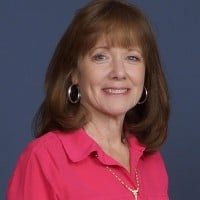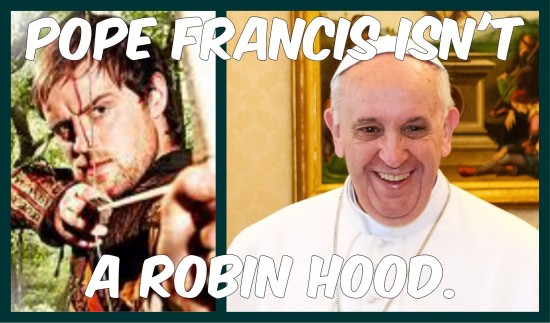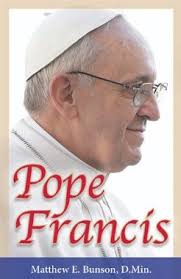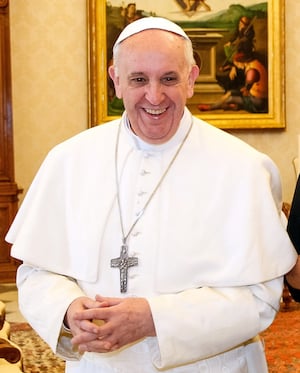Robin Hood is a legendary folk hero who stole from the rich and gave to the poor. He is said to have revolted under a corrupt king (scholars do not agree on which king) by stealing from the rich then redistributing it to the poor.
The point of Robin Hood is less about actual history and more about what he represents. He is a symbol of the underdog winning against corruption. And isn’t that the Catholic way?
Yes. And no. The desire for social and economic justice is Catholic, but making the cause primarily about economics rather than rooting out the sin causing the injustice attacks the problem from the wrong angle. It is this very misappropriation of values that has waylaid some proponents of Liberation Theology, a Catholic social movement born in Latin America, the land of Pope Francis’s birth. Within this movement are traps that lead away from the Church. It is this very trap that ensnared Robin Hood—using force to even the score. It is the same trap that was a test for Pope Francis as a young priest and it reveals much about who our new pope is.
Pope Francis and Liberation Theology
Liberation Theology was actually the first major challenge that confronted Fr. Jorge Mario Bergoglio, according to Dr. Matthew Bunson, author of the new book, Pope Francis. Bunson is an author of thirty books and one of America’s leading authorities on the papacy and the Church.
In Pope Francis, Bunson begins with Pope Benedict’s stunning resignation, and then takes us halfway across the world into the life of Cardinal Jorge Mario Bergoglio, the archbishop of Buenos Aires, Argentina.
“He bought a return ticket, and his friends, aghast at the state of his battered old shoes, implored him to accept the gift of a new pair. Wearing his new shoes, he set out for the Vatican.” Bunson explains. Then, on March 13, Cardinal Jorge Mario Bergoglio was announced as the unexpected 265th Successor of Peter. Much of the world was left to wonder: who is this man?
Bunson introduces us to our new Pope in a personal way, detailing his early life, his priesthood as a Jesuit during a dark time in Argentina’s history, his work as archbishop of Buenos Aires, and his time as one of the most influential cardinals in Latin America.
After the announcement, it did not take long for the secular media and spin-doctors to associate Pope Francis with sinister activities, accusing him of taking part in kidnappings and Marxist associations often associated with Liberation Theology. Bunson shows that while Pope Francis worked in the trenches, truly serving the poor, he never diverted from the path of authentic Catholic teaching.
Liberation Theology began in Latin America in the 1950s–1960s as a moral reaction to poverty caused by social injustice. The Church has always offered the teaching of the Gospel of Jesus Christ as a way to freedom and liberation. Liberation Theology expanded that to include freedom from the cultural, economic, social and political slavery that emanates ultimately from sin.
Bunson explains in his book that after the Second Vatican Council, currents of thought developed that focused not on liberation from sin and its dehumanizing effects but rather liberation that often aligned with Marxist philosophies of revolution. The theologies of liberation were difficult to define, mixing concern for the poor with Church teaching, but also sometimes becoming more worldly and less spiritual; more about materialism and less about overcoming sin.
“In its most extreme form, the language of liberation theology carried overtones of Marxism and the Marxist revolutionary ideas being promoted throughout Central America by guerrilla movements,” Bunson writes.
Cardinal Ratzinger’s Caution
At this time, Cardinal Joseph Ratzinger, the future Pope Benedict XVI, the prefect for the Congregation of the Doctrine of the Faith (CDF), issued two documents, affirming the shared values of liberation theology while cautioning that they needed to be guided so as not to slip into an earthly gospel.
Bunsen states that after the collapse of the Soviet Union and the decline in Marxism, many practitioners of liberation theologies reformed with an authentic vision of Pope John Paul II’s own promotion of justice and peace in the poorest countries of the world. Others segments continued to veer off course into radical leftist politics.
“Very early in his own ministry,” Bunson writes, “Fr. Bergoglio distanced himself from it as he saw it as an aberration of the Church’s authentic concern for the poor and the call to authentic justice rooted in the Gospel and nurturing an encounter with Jesus Christ.”
In Pope Francis, Bunson quotes Fr. Federico Lombardi as stating, “Regarding ‘liberation theology’: Bergoglio has always referred to the Instructions of the Congregation for the Doctrine of the Faith. He has always rejected violence, saying that its price is always paid by the weakest.”
The strain of Liberation Theology where economic gains were primary over the spiritual element of overcoming the slavery of sin makes the difference between a Robin Hood and a Pope Francis. Both start with the same Christian value of loving the poor and desiring the dignity everyone deserves, but it ultimately leads down different paths.
Bunson reports, “He [Pope Francis] was concerned that liberation theology could bring about the politicization of the Church,” said Bunson, “twisting Christ into a liberator solely from social or political inequalities or from oppressive power structures instead of teaching faithfully that the Son of God brings salvation and hope of eternal life.”
Pope Francis does not accept injustice, but like his namesake he is committed to reform, not leftist revolt. “He chose the name Francis in honor of Saint Francis of Assisi,” Bunson writes, “and he did so with a deep understanding of the two most lasting legacies of il Poverello —a love for the poor and a commitment to reform.”
Like Francis of Assisi, he says Pope Francis wants the Church to be poor in spirit, humble and Christ like while serving the poor and defenseless while working toward reform.
Again, unlike Robin Hood who championed for the poor against the rich, Pope Francis is against no one but instead stands truly as the bridge builder. “His origins, his learning, and his own years of service as a pastor over a city that has some of the wealthiest residents in South America and some of the poorest has prepared him for this role,” Bunson writes. “He was a shepherd to them all, and he labored to help everyone in his care encounter Christ. And now he will work to do the same for the world.”
Purchase Pope Francis, by Matthew Bunson, and support CatholicMom.com!
Be sure to check out our Book Notes archive.
Copyright 2013 Patti Maguire Armstrong
About the Author

Patti Maguire Armstrong
Patti Maguire Armstrong is an award-winning journalist and author, managing editor and co-author of bestselling Amazing Grace Series. Her latest books are Dear God, I Don't Get It, Dear God, You Can't Be Serious!, What Would Monica Do?, and Holy Hacks. Patti worked in social work and public administration before freelance writing while she and Mark raised their 10 children. Twitter: @PattiArmstrong; blogs at PattiMaguireArmstrong.com






.png?width=1806&height=731&name=CatholicMom_hcfm_logo1_pos_871c_2728c%20(002).png)
Comments